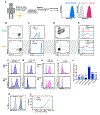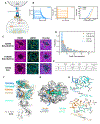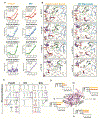Isolation of a Structural Mechanism for Uncoupling T Cell Receptor Signaling from Peptide-MHC Binding
- PMID: 30053426
- PMCID: PMC6140336
- DOI: 10.1016/j.cell.2018.06.017
Isolation of a Structural Mechanism for Uncoupling T Cell Receptor Signaling from Peptide-MHC Binding
Abstract
TCR-signaling strength generally correlates with peptide-MHC binding affinity; however, exceptions exist. We find high-affinity, yet non-stimulatory, interactions occur with high frequency in the human T cell repertoire. Here, we studied human TCRs that are refractory to activation by pMHC ligands despite robust binding. Analysis of 3D affinity, 2D dwell time, and crystal structures of stimulatory versus non-stimulatory TCR-pMHC interactions failed to account for their different signaling outcomes. Using yeast pMHC display, we identified peptide agonists of a formerly non-responsive TCR. Single-molecule force measurements demonstrated the emergence of catch bonds in the activating TCR-pMHC interactions, correlating with exclusion of CD45 from the TCR-APC contact site. Molecular dynamics simulations of TCR-pMHC disengagement distinguished agonist from non-agonist ligands based on the acquisition of catch bonds within the TCR-pMHC interface. The isolation of catch bonds as a parameter mediating the coupling of TCR binding and signaling has important implications for TCR and antigen engineering for immunotherapy.
Keywords: CD45; MHC; TCR; catch bond; ligand discrimination; molecular dynamics; signaling; structure.
Copyright © 2018 Elsevier Inc. All rights reserved.
Conflict of interest statement
Declaration of Interests:
LVS, MHG, and KCG are co-founders of 3T Biosciences.
Figures







References
-
- Beddoe T, Chen Z, Clements CS, Ely LK, Bushell SR, Vivian JP, Kjer-Nielsen L, Pang SS, Dunstone M.a., Liu YC, et al. (2009). Antigen ligation triggers a conformational change within the constant domain of the alphabeta T cell receptor. Immunity 30, 777–788. - PubMed
Publication types
MeSH terms
Substances
Grants and funding
- P01 AI091580/AI/NIAID NIH HHS/United States
- U01 CA202241/CA/NCI NIH HHS/United States
- U54 CA199090/CA/NCI NIH HHS/United States
- WT101609MA/WT_/Wellcome Trust/United Kingdom
- HHMI/Howard Hughes Medical Institute/United States
- WT_/Wellcome Trust/United Kingdom
- P41 GM103393/GM/NIGMS NIH HHS/United States
- R01 AI048540/AI/NIAID NIH HHS/United States
- R01 AI103867/AI/NIAID NIH HHS/United States
- R01 NS071518/NS/NINDS NIH HHS/United States
- U19 AI057229/AI/NIAID NIH HHS/United States
- F31 CA216926/CA/NCI NIH HHS/United States
- R01 AI129543/AI/NIAID NIH HHS/United States
- R01 AI096879/AI/NIAID NIH HHS/United States
LinkOut - more resources
Full Text Sources
Other Literature Sources
Molecular Biology Databases
Research Materials
Miscellaneous

